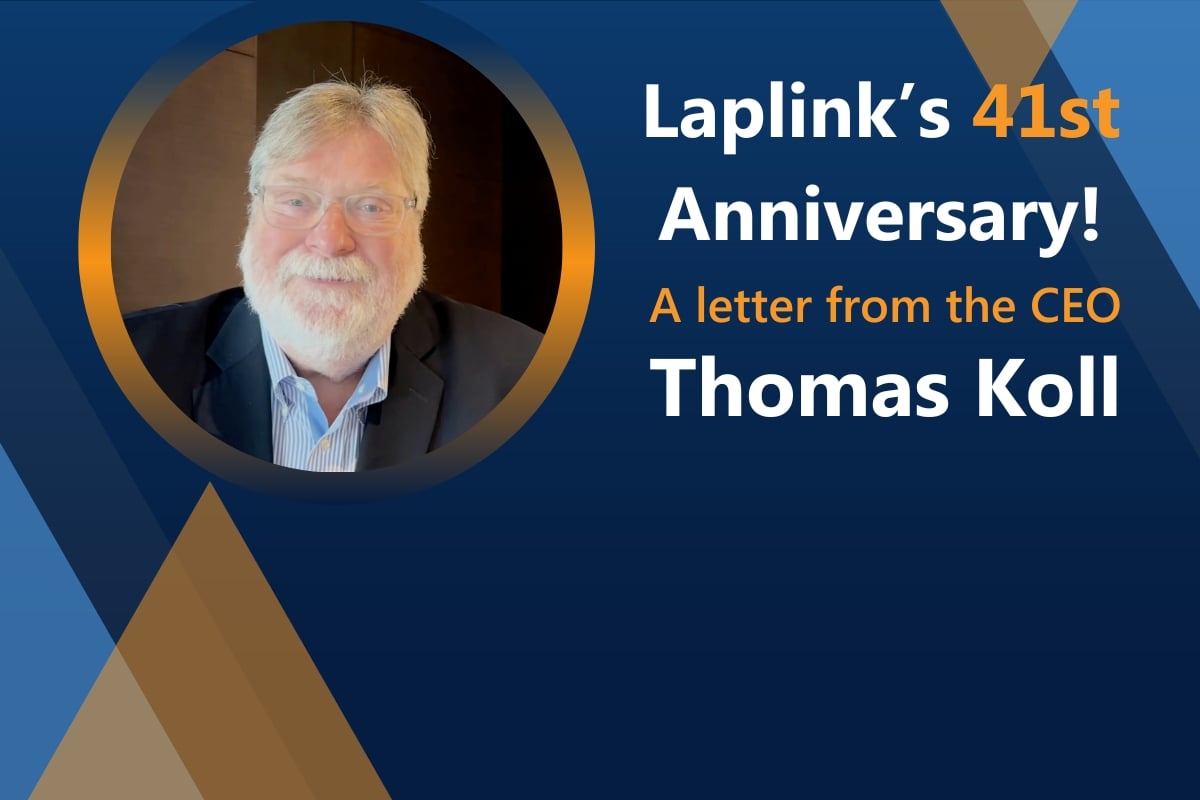Try PCmover
Please note the Evaluation copy of PCmover Enterprise requires you to be logged into a domain when testing. If you would like to test Enterprise without this requirement, please contact corpsales@laplink.com to receive an alternate copy of the software.
Thank you for your interest, and for choosing Laplink Software!
Contact Sales

Embracing the Future: Laplink's Journey with AI and PCmover
Artificial Intelligence (AI), that enigmatic fusion of human ingenuity and computational prowess, stands at the precipice of our collective imagination. It is both a beacon of promise and a harbinger of caution. As Yann LeCun aptly puts it, AI is an extension of our innate intelligence, a digital counterpart that mirrors our cognitive faculties. But what does this electrifying force mean for our future? Fei-Fei Li reminds us that AI, akin to the advent of electricity, will permeate every facet of existence. It is not merely a technological leap; it’s a seismic shift that reverberates across industries, reshaping landscapes and redefining norms.
Yet, amidst the awe, there’s a whisper of trepidation. Sam Altman playfully acknowledges that while AI might lead to our demise (the stuff of sci-fi nightmares), it will also birth remarkable companies. It’s this paradox—the dance between creation and catastrophe—that fuels our fascination. The genius of Alan Turing, the father of modern computing, envisioned AI’s ability to deceive, to blur the lines between silicon and synapse. And then there’s the audacious prophecy of Ray Kurzweil: by 2029, AI could match human intelligence, and by 2045, it might surpass it a billionfold. Such exponential growth tantalizes our curiosity, urging us to peek beyond the veil of the ordinary.
Yet, caution echoes through the corridors of wisdom. Stephen Hawking, the cosmic sage, warned that full AI development could spell our demise. It’s a stark reminder that our creations, like Prometheus’s fire, can either illuminate or consume. As we tread this uncharted terrain, we must heed the words of visionaries. Elon Musk invokes the demon, urging us to wield AI with reverence. Andrew Ng likens it to electricity, a force that will illuminate our path but also cast shadows. And in the quiet wisdom of Ginni Rometty, AI becomes not artificial, but augmentative—an ally in our quest for understanding.
So, here we stand, at the crossroads of algorithms and aspirations. Let us embrace AI’s potential, nurture its ethical roots, and steer its course toward enlightenment. For in this dance of silicon and soul, we script our destiny—one line of code at a time.
The introduction to my letter (created by ChatGPT), which discusses how Artificial Intelligence will shape our thinking and the plans for our companies and products, illustrates the breadth of opinions we face contemplating the road for our progress. Despite many warnings, the industry and their customers strongly believe that AI is as important as the Internet or even electricity for mankind. That said and agreed, few can make predictions on where we will be even in three to five years given the abilities for accelerated developments, creations of new companies, availability of massive capital, and the challenges to the human mind. Today we are making decisions that shape our futures knowing quite well that at any moment the just-launched technologies will be disrupted and even put on their head with new thinking and even newer technologies.
Every company must consider implementing AI processes to improve its own efficiencies, bring products to market and, above all, provide better service to its customers or be left behind. For Laplink, going into our 42nd year of existence, we must break with traditional processes and assumptions, which might not always be easy, and we must ask ourselves every day how we can improve and look at things differently. With great attention we watch the market, as AI is already making it possible for people to change their very existence.
At Laplink, we started very early to establish a core working group to understand how we can apply the very first hot AI products to our internal processes knowing that the more efficiency we can achieve internally, the more time we can spend on building better products and helping our customers. Secondly, we worked very closely with one of our strategic partners, Intel, to test and evaluate the newest hardware so that we can better understand the available opportunities, given the power of the newest chips and PC technologies. Thirdly, we looked at our own Laplink products to pinpoint areas where we can make meaningful improvements. Naturally these are not linear developments, but reiterative processes, learning new technologies and taking steps forward.
Our focus with our products has been two-fold. First, identify areas that can be enhanced with current AI technologies, which will improve usability of our products and how a user can change certain program options to easily “manipulate” its outcome. Users increasingly like to interact with their software, and ChatGPT gave the industry a tremendous boost, so it is important to provide this option to our users. In PCmover, our Flagship product, that means we enable users to understand what PCmover will transfer, change the options with descriptive commands instead of “clicking away and hoping for the best”, and learn about the results. Secondly, we focus on improving our ability to collect data during the migration process. In aggregate and anonymous form and leverage this data to provide new insights to PC deployment projects for business and non-business organizations to optimize operations or prevent failures before they occur. This certainly will be a longer process than the first focus but will help gain more knowledge to reduce costs and time.
During Summer of 2024, Laplink plans to launch PCmover AI, making it easier for users to understand and modify the migration process. Through interacting with a conversational AI interface in PCmover, users can change the process and influence the outcome. In PCmover AI, you can preview the migration results and change your profiles, settings, and selections by simply interacting with the AI assistant for a better outcome. “Don’t move Microsoft Office” or “don’t move any video files” are commands that change the process and outcome of the migration to the new PC. Simply type in your wishes and the AI assistant will create the machine commands to alter the transfer, eliminating the need for users to configure the transfer with multiple clicks. If you would like to sign up for a preview copy, please register here.
In our 41 years, Laplink has always aspired to build the best products for the market and for our customers. Many awards and accolades have proven our success and still, looking back at earlier products, we always can see how naïve we have been. This perspective also applies to the industry as a whole. We have made so much progress but must realize again and again that our constant need for better ways drives ingenuity and research forward into spaces we could not imagine at the current time. The old saying that Bill Gates used in many presentations - “the future is yet to come” - is alive and “on the money”. Looking forward with focus and willingness to learn is the best defense against complacency.
Best regards,
Thomas Koll, Chairman of the Board & CEO, Laplink Software
Thomas Koll, CEO

As Chairman of the Board and CEO of Laplink, Thomas guides the company’s strategic direction. Prior to joining Laplink in 2003, Thomas was Chairman of the Board for Infowave, where he was involved in interfacing with global business and financial communities. Thomas also served as Infowave’s Chief Executive Officer from February 2001 to April 2002. Prior to joining Infowave, Thomas worked at Microsoft for more than 13 years. He was Corporate Vice President of Microsoft’s Network Solutions Group where he was responsible for Microsoft’s worldwide business with telecommunication companies. Thomas was instrumental in developing Microsoft’s vision for the communications industry and led the development of strategic partnerships in mobility, broadband and hosting. Previously, he was General...
Read more about Thomas Koll, CEO...

Add Comment